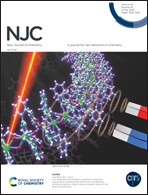Ultrafast synthesis of magnetic hollow carbon nanospheres for the adsorption of quinoline from coking wastewater†
Abstract
Magnetic hollow carbon nanospheres (MHCNSs) with a uniform particle size (40 nm) were ultrafast synthesized in 80 s by a novel microwave-assisted solvothermal method. MHCNSs exhibited an abundant pore structure and high surface activity. Further, their growth mechanism and adsorption property towards quinoline in coking wastewater were discussed. The results indicate that the surfactant P123 plays a template role in inducing the growth of MHCNSs. At 298 K, MHCNSs exhibited a saturated adsorption amount of 155.23 mg g−1 towards quinoline in coking wastewater. Also, they showed excellent regeneration and magnetic separation properties. Through investigating the effect of pH, it was found that MHCNSs realized their best adsorption capacity at pH = 7, and they possessed a relatively stable adsorption capacity in slightly alkaline coking wastewater. The adsorption kinetics, isotherm and thermodynamics results demonstrate that the pseudo-second-order and Langmuir–Freundlich are the most suitable models for quinoline adsorption on MHCNSs, and the process belongs to spontaneous and exothermic chemisorption. In general, MHCNSs could be a potential adsorbent for the effective adsorption of quinoline from coking wastewater.



 Please wait while we load your content...
Please wait while we load your content...